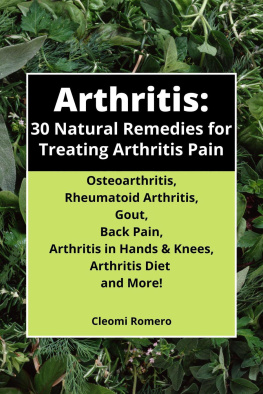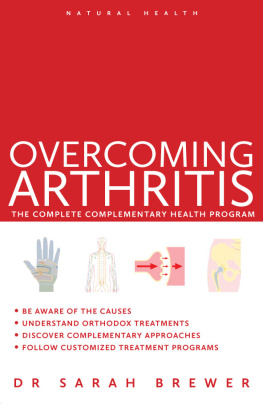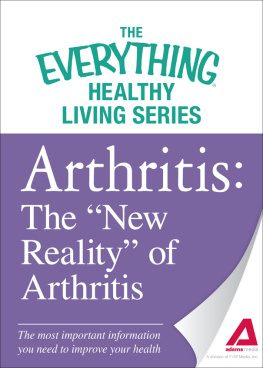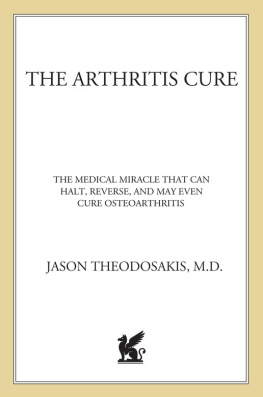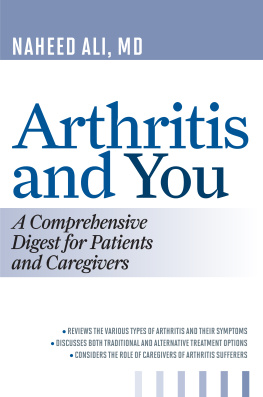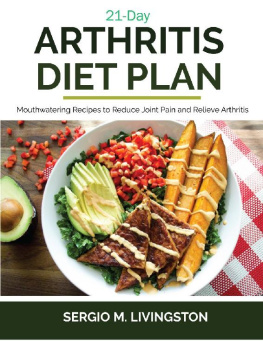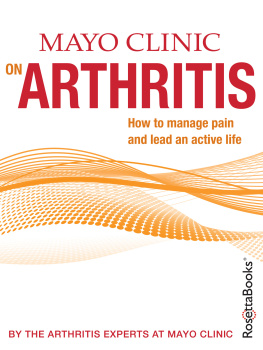THE
NEW SCIENCE
OF
OVERCOMING ARTHRITIS


Copyright 2013 by Dr. Thomas Vangsness and Greg Ptacek
Photos by CT Vangsness III
All rights reserved. No part of this publication may be reproduced, stored in a retrieval system, or transmitted, in any form or by any means, electronic, mechanical, photocopying, recording, or otherwise, without the prior written permission of the publisher. For information, address Da Capo Press, 44 Farnsworth Street, 3rd Floor, Boston, MA 02210
Designed by Cynthia Young
Cataloging-in-Publication data for this book is available from the Library of Congress.
First Da Capo Press edition 2013
ISBN: 978-0-7382-1723-9 (e-book)
Published by Da Capo Press
A Member of the Perseus Books Group
www.dacapopress.com
Note: The information in this book is true and complete to the best of our knowledge. This book is intended only as an informative guide for those wishing to know more about health issues. In no way is this book intended to replace, countermand, or conflict with the advice given to you by your own physician. The ultimate decision concerning care should be made between you and your doctor. We strongly recommend you follow his or her advice. Information in this book is general and is offered with no guarantees on the part of the authors or Da Capo Press. The authors and publisher disclaim all liability in connection with the use of this book. The names and identifying details of people associated with events described in this book have been changed. Any similarity to actual persons is coincidental.
Da Capo Press books are available at special discounts for bulk purchases in the U.S. by corporations, institutions, and other organizations. For more information, please contact the Special Markets Department at the Perseus Books Group, 2300 Chestnut Street, Suite 200, Philadelphia, PA, 19103 or call (800) 810-4145, ext. 5000, or e-mail .
10 9 8 7 6 5 4 3 2 1
To my family and my four children for inspiring me every day, to my students, residents, and fellows for sharing with me the joy of learning, and to my patients who strive to achieve their optimal quality of life through an active, healthy lifestyle.
Contents
Arthritiswe hear about it every day. Take this medicine or that supplement, and you will feel better and live free of pain once again. Marketed with buckets full of cash from international pharmaceutical corporations, arthritis pills are a $40-billion-a-year business, which is why TV is saturated with commercials for arthritis pain relief.
But what do we really know about this disease? Just what is arthritis?
Heres one sure bet about you and arthritis: youre very likely to suffer from some form of it. In fact, if you live to age seventy-five, you have a 75 percent chance of suffering from osteoarthritis, the most prevalent form of the disease.
As Ill discuss in the coming pages, arthritis is actually many different afflictions, some only remotely related. But they all share a common symptom: inflammation around the joint, causing pain, swelling, and stiffness.
In this book, Ill share with you my thirty years of experience as an orthopedic surgeon and clinician and my more recent cutting-edge stem cell research that offers the hope of cellular regeneration of cartilagethe holy grail of arthritis treatment. Imagine if one day soon your doctor wouldnt prescribe a pill to relieve your aching knee but instead injected a serum that would not only eliminate the pain and inflammation but also possibly reverse the effects of arthritis!
The Arthritis Epidemic
First, however, lets put arthritis into perspective. For the patient, arthritis means suffering the symptomsaches and pains around jointson a daily basis. Even worse, for the majority of sufferers, arthritis limits their common everyday activities and decreases the quality of their lives.
In fact, arthritis is the most common chronic disease in our society. Its more common than heart disease, cancer, asthma, hypertension, or diabetes. It ranks as the leading cause of disability among people age sixty-five and older, but it is also a major cause of work-related disability.
Currently, approximately fifty million adults in the United States (about one in six) are affected by arthritis, but this number is predicted to increase to sixty to seventy million by the year 2030.
This is a problem of epidemic proportions, and if nothing else changed, this alone clearly makes arthritis one of the most serious health problems in our society. But there are two disturbing new trends that underscore that the problem is getting worse, not better: the overall rate of osteoarthritis is increasing, and the age of sufferers is decreasing.
Decreasing Age, Increasing Number of Sufferers
While most chronic diseases in America are on a slow decline, arthritis is on a steady increase. Despite its reputation as a disease of old age, the average age of osteoarthritis onset has fallen to forty-seven, and about three out of every five people with arthritis are under sixty-five years of age.
In other words, a greater proportion of people in the United States are suffering from arthritis, and they are suffering at a younger age, than a decade ago. I am seeing this in my own practicea huge surge of patients exhibiting common symptoms of arthritis at younger ages than was the case twenty or even ten years ago.
Societal Costs
The growing number of arthritis sufferers comes at a tremendous price for society. Arthritis-related expenditures for just one personlost wages, medical treatment, and other related expensescan come to more than $150,000 in his or her lifetime. Total costs from arthritis in 2012 are estimated to be approximately $81 billion, with that figure expected to rise dramatically in the next two decades as the baby boom generation comes into its senior years. Adults age sixty-five and older are approximately 13 percent of the US population, yet they accounted for over one-third of the total dollars spent on personal health care.
Although nearly a hundred forms of arthritis affect our population, osteoarthritis is by far the most prominent, responsible for nearly half of all cases. More than 90 percent of osteoarthritis patients report functional limitations in their daily activities. The loss of mobility can make it difficult or impossible to carry out ordinary life activities such as exercising, grocery shopping, house cleaning, gardening, and even dressing oneself. This loss of function can lead to lost wages, job transfers, and even unemployment.
Osteoarthritis accounts for approximately forty million physicians visits and half a million hospitalizations a year. Patients with symptomatic osteoarthritis use twice as much medical care as patients without arthritis. Other expenses associated with arthritis, including behavioral (lifestyle) changes and adaptations such as change of residence, transportation difficulties, over-the-counter medication, medicines not regulated by the US Food and Drug Administration (FDA), and assistive devices for personal care, only add to the burden. We can anticipate that osteoarthritis-related costs alone will approach $282 billion annually by 2030.
Silent Epidemic
We can take steps to reduce our chances of being affected by arthritis. It is my hope that the facts, figures, analysis, and recommendations presented in this book will reveal to you the problemwhich is truly of epidemic proportionsthat we face in combating the disease. More important, Ill provide you with concrete ways to fight the disease, based on the very latest in scientific information.
Next page

